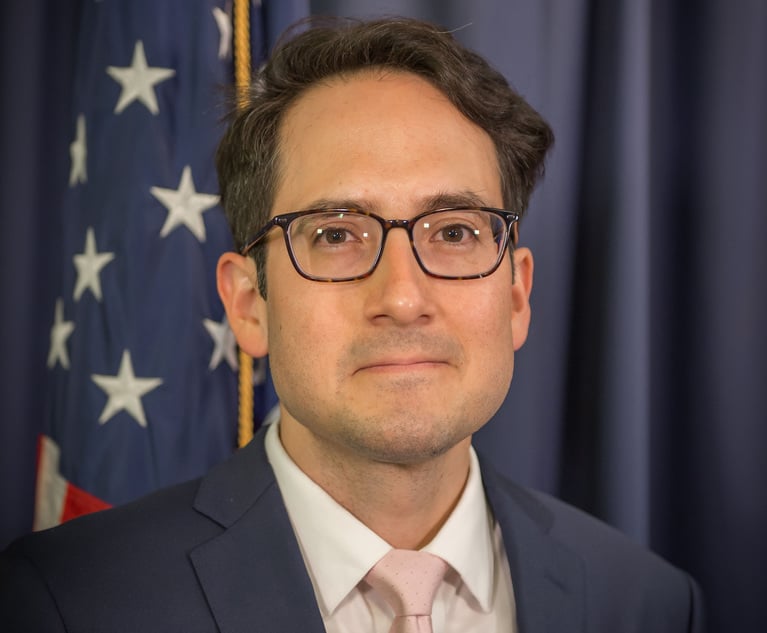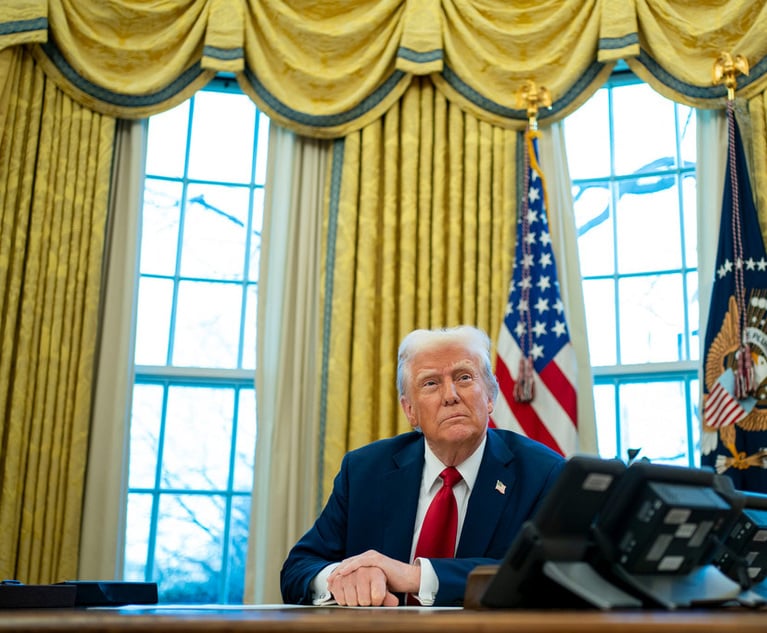IP: 6 practical ways to improve your patent strategy in 2012
The new year is the perfect time for improvements as another wave of AIA provisions are set to go into effect.
January 24, 2012 at 06:53 AM
7 minute read
The original version of this story was published on Law.com
The New Year is a traditional time to reflect on how we can improve ourselves and our businesses. It also is a prime time to revamp your organization's intellectual property strategy of as another wave of provisions in the Leahy-Smith America Invents Act (AIA) come into effect.
Here are six simple and practical resolutions for getting a jump-start on patent reform.
1. Enhance your docketing or file system to track what version of U.S. patent law applies to individual patent applications. AIA does not simply substitute new laws for the old—the U.S. patent system will operate under two sets of laws for many years. AIA defines effective dates, but many provisions are triggered only when a claim in a patent or patent application has a certain effective filing date.
For example, post-grant review proceedings go into effect on Sept.16, 2012, but they generally only apply to patents containing a claim with an effective filing date after March 16, 2013.
2. Enhance monitoring of competing patent applications and patents. You can maximize your options by understanding what other patent claims are pending or issuing in your field. For example, after Sept. 16, 2012, third parties can submit prior art in the prosecution of another party's patent application with an explanation of why the prior art is relevant to the claimed invention. Additionally, the new derivation proceedings will go into effect on March 13, 2013, but there are deadlines for initiating such a proceeding based on the publication or issue date of another parties' patent claims.
3. Be ready to use inter partes review to resolve patent disputes. As of Sept. 16, 2012, inter partes reexaminations before the examiners of the Central Reexamination Unit will be replaced with inter partes review before the administrative patent judges of the Patent Trial and Appeal Board. Inter partes review should be a cost-effective alternative or supplement to patent infringement litigation. AIA provided a broad framework for inter partes review, but further details will emerge in the next few months as the USPTO publishes and finalizes its procedural rules.
4. Expedite prosecution of your most important patent applications. Already in effect is an AIA mechanism for patent applicants to speed up the patent process by paying an additional petition fee ($4,800) for prioritized examination. The United States Patent and Trademark Office (USPTO) is chipping away at the backlog of nearly 700,000 patent applications awaiting examination, but non-expedited examination, on average, takes about three years. As of Sept. 16, 2012, the AIA also will prioritize examination of applications important to the national economy or competitiveness.
5. Use supplemental examination to protect patents from allegations of inequitable conduct. After Sept. 16, 2012, patent owners can file for supplemental examination of their own patents based on information that raises a substantial new question of patentability. Unlike ex parte reexamination, the information is not limited to prior art issues. This provision may be particularly useful if information is uncovered in pre-suit review of a patent file or during patent litigation.
6. Plan ahead for conversion to the first-to-file system. The modified first-to-file system will become effective March 16, 2013. Evaluate your invention disclosure system to eliminate delays and ensure your organization has the earliest filing date for your inventions. Also, be aware of the impact of the one-year grace period, and the potential impact in the U.S. and foreign patent systems of publications and other disclosures.
The New Year is a traditional time to reflect on how we can improve ourselves and our businesses. It also is a prime time to revamp your organization's intellectual property strategy of as another wave of provisions in the Leahy-Smith America Invents Act (AIA) come into effect.
Here are six simple and practical resolutions for getting a jump-start on patent reform.
1. Enhance your docketing or file system to track what version of U.S. patent law applies to individual patent applications. AIA does not simply substitute new laws for the old—the U.S. patent system will operate under two sets of laws for many years. AIA defines effective dates, but many provisions are triggered only when a claim in a patent or patent application has a certain effective filing date.
For example, post-grant review proceedings go into effect on Sept.16, 2012, but they generally only apply to patents containing a claim with an effective filing date after March 16, 2013.
2. Enhance monitoring of competing patent applications and patents. You can maximize your options by understanding what other patent claims are pending or issuing in your field. For example, after Sept. 16, 2012, third parties can submit prior art in the prosecution of another party's patent application with an explanation of why the prior art is relevant to the claimed invention. Additionally, the new derivation proceedings will go into effect on March 13, 2013, but there are deadlines for initiating such a proceeding based on the publication or issue date of another parties' patent claims.
3. Be ready to use inter partes review to resolve patent disputes. As of Sept. 16, 2012, inter partes reexaminations before the examiners of the Central Reexamination Unit will be replaced with inter partes review before the administrative patent judges of the Patent Trial and Appeal Board. Inter partes review should be a cost-effective alternative or supplement to patent infringement litigation. AIA provided a broad framework for inter partes review, but further details will emerge in the next few months as the USPTO publishes and finalizes its procedural rules.
4. Expedite prosecution of your most important patent applications. Already in effect is an AIA mechanism for patent applicants to speed up the patent process by paying an additional petition fee ($4,800) for prioritized examination. The United States Patent and Trademark Office (USPTO) is chipping away at the backlog of nearly 700,000 patent applications awaiting examination, but non-expedited examination, on average, takes about three years. As of Sept. 16, 2012, the AIA also will prioritize examination of applications important to the national economy or competitiveness.
5. Use supplemental examination to protect patents from allegations of inequitable conduct. After Sept. 16, 2012, patent owners can file for supplemental examination of their own patents based on information that raises a substantial new question of patentability. Unlike ex parte reexamination, the information is not limited to prior art issues. This provision may be particularly useful if information is uncovered in pre-suit review of a patent file or during patent litigation.
6. Plan ahead for conversion to the first-to-file system. The modified first-to-file system will become effective March 16, 2013. Evaluate your invention disclosure system to eliminate delays and ensure your organization has the earliest filing date for your inventions. Also, be aware of the impact of the one-year grace period, and the potential impact in the U.S. and foreign patent systems of publications and other disclosures.
This content has been archived. It is available through our partners, LexisNexis® and Bloomberg Law.
To view this content, please continue to their sites.
Not a Lexis Subscriber?
Subscribe Now
Not a Bloomberg Law Subscriber?
Subscribe Now
NOT FOR REPRINT
© 2025 ALM Global, LLC, All Rights Reserved. Request academic re-use from www.copyright.com. All other uses, submit a request to [email protected]. For more information visit Asset & Logo Licensing.
You Might Like
View All
Fired NLRB Member Seeks Reinstatement, Challenges President's Removal Power

GOP-Led SEC Tightens Control Over Enforcement Investigations, Lawyers Say

GOP Now Holds FTC Gavel, but Dems Signal They'll Be a Rowdy Minority
6 minute read
Trump's Inspectors General Purge Could Make Policy Changes Easier, Observers Say
Trending Stories
Who Got The Work
J. Brugh Lower of Gibbons has entered an appearance for industrial equipment supplier Devco Corporation in a pending trademark infringement lawsuit. The suit, accusing the defendant of selling knock-off Graco products, was filed Dec. 18 in New Jersey District Court by Rivkin Radler on behalf of Graco Inc. and Graco Minnesota. The case, assigned to U.S. District Judge Zahid N. Quraishi, is 3:24-cv-11294, Graco Inc. et al v. Devco Corporation.
Who Got The Work
Rebecca Maller-Stein and Kent A. Yalowitz of Arnold & Porter Kaye Scholer have entered their appearances for Hanaco Venture Capital and its executives, Lior Prosor and David Frankel, in a pending securities lawsuit. The action, filed on Dec. 24 in New York Southern District Court by Zell, Aron & Co. on behalf of Goldeneye Advisors, accuses the defendants of negligently and fraudulently managing the plaintiff's $1 million investment. The case, assigned to U.S. District Judge Vernon S. Broderick, is 1:24-cv-09918, Goldeneye Advisors, LLC v. Hanaco Venture Capital, Ltd. et al.
Who Got The Work
Attorneys from A&O Shearman has stepped in as defense counsel for Toronto-Dominion Bank and other defendants in a pending securities class action. The suit, filed Dec. 11 in New York Southern District Court by Bleichmar Fonti & Auld, accuses the defendants of concealing the bank's 'pervasive' deficiencies in regards to its compliance with the Bank Secrecy Act and the quality of its anti-money laundering controls. The case, assigned to U.S. District Judge Arun Subramanian, is 1:24-cv-09445, Gonzalez v. The Toronto-Dominion Bank et al.
Who Got The Work
Crown Castle International, a Pennsylvania company providing shared communications infrastructure, has turned to Luke D. Wolf of Gordon Rees Scully Mansukhani to fend off a pending breach-of-contract lawsuit. The court action, filed Nov. 25 in Michigan Eastern District Court by Hooper Hathaway PC on behalf of The Town Residences LLC, accuses Crown Castle of failing to transfer approximately $30,000 in utility payments from T-Mobile in breach of a roof-top lease and assignment agreement. The case, assigned to U.S. District Judge Susan K. Declercq, is 2:24-cv-13131, The Town Residences LLC v. T-Mobile US, Inc. et al.
Who Got The Work
Wilfred P. Coronato and Daniel M. Schwartz of McCarter & English have stepped in as defense counsel to Electrolux Home Products Inc. in a pending product liability lawsuit. The court action, filed Nov. 26 in New York Eastern District Court by Poulos Lopiccolo PC and Nagel Rice LLP on behalf of David Stern, alleges that the defendant's refrigerators’ drawers and shelving repeatedly break and fall apart within months after purchase. The case, assigned to U.S. District Judge Joan M. Azrack, is 2:24-cv-08204, Stern v. Electrolux Home Products, Inc.
Featured Firms
Law Offices of Gary Martin Hays & Associates, P.C.
(470) 294-1674
Law Offices of Mark E. Salomone
(857) 444-6468
Smith & Hassler
(713) 739-1250






